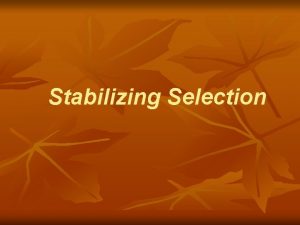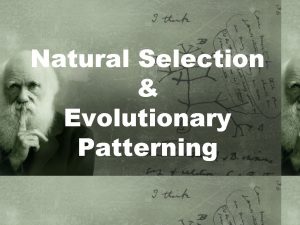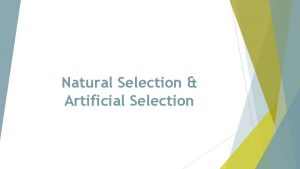Natural Selection Definition Natural selection is the process





- Slides: 5

Natural Selection Definition Natural selection is the process that causes groups of organisms to change, or evolve, over time. Considering that animals must inherit their genetics from their parents or ancestors, and that the environment is constantly changing, it can be seen that no organism is perfectly adapted to its environment. If a parent were perfectly adapted to the environment, the environment will change, leaving the offspring maladapted to the environment. Luckily for all organisms, genetic variability causes each individual to be slightly different. These slight differences in performance can lead to differences in the amount each individual reproduces. By reproducing more, an individual creates more of the genetic variabilities that helped it succeed. The offspring of these individuals will also benefit from the genetic variables that allowed for their parents to succeed. Organisms without these genetic adaptations will not reproduce as much, and in this way their lines will someday cease to exist. Nature constantly exerts a selective force on the different genetic combinations that try to reproduce

• Types and Examples of Natural Selection • As animals diversify, and fill different niches, the pressures exerted on them can change in many ways. The functional requirements to be bird are much different than those required to be a fish. Their food is different, the medium they exist in is different, and they must obtain oxygen in a different way. Natural selection thus selects for very different looking animals to fill the different niches of the ecosystem. • Regardless of the trait, natural selection tends to do one of three things to a population. It can keep the trait the same, stabilizing selection, move the trait in one direction, directional selection, or select for the extreme values of the trait, diversifying selection. In addition to being classified by the effects it causes, natural selection can also be classified by the relationships of the organisms causing the natural selection, and sometimes the selection can be made by abiotic factors.

• • Type 1: Stabilizing Selection Most traits in the animal kingdom can be described by a bell curve, in terms of their distribution. Most animals of a certain species tend to show the same trait or feature, of relatively the same size. There always some exceptions of larger or smaller traits in certain individuals, but generally most individuals sit somewhere in the middle. Stabilizing selection is a form of natural selection that screens against the outliers, or exceptions to the trait. The screen prevents those animals from reproducing as much as the “normal” or more regular individuals. Because of this bias, more babies are born that are “normal” and less outliers are seen in each consecutive generation. It is in this way that species can become very distinct from other species, yet all members of a species will look exactly alike. Example of Stabilizing Selection Because actual life is really complex, all of the following examples will be simplified hypothetical versions. For stabilizing selection, imagine a population of mice that lives in the woods. Some of the mice are black, some are white, and some are grey. If the mice had no predators, and no other forces acting on the color of their coat, it would have no reason to change and would only change randomly in response to certain mutations in the DNA. However, that is not the case with these mice. They have lots of predators. In the daytime, the mice are preyed on by foxes and house cats from a nearby village. In the nighttime, the owls and other predators scour the dark for dinner. Either way, the mice are in a tough position. But not all the mice face the same risk at all times. In the daytime, the black mice are much easier to spot, and predators eat more black mice. At night, the white mice stand out like little lights to the owls, and many more white mice are eaten. The grey mice are the only ones who survive more both during the day and at night. By the next generation, there will be many less black and white mice to reproduce. The genes that produce the grey mice will be replicated more than the others, creating many more grey mice in the next generation. After a few generations of a strong selective pressure, the entire population could be grey. It depends entirely on the genetic makeup of the trait, but in some cases a single trait is selected for and the rest are lost from the population. In other cases, the black and white traits could just become rarely seen traits. Retaining the traits can be an advantage when the predators change. For instance, if all the owls and night predators disappeared, it would be more beneficial to be black. The black mice would then take off, and become more frequent in the population.

• • Type 2: Directional Selection Directional selection is a type of natural selection that occurs when one side of the spectrum of a certain trait is favored over the other. For instance, if the smallest organisms get eaten, and larger organisms are totally protected, the population will tend to get much larger. If the opposite is true, the population will decrease in size over time. It is also using directional selection artificially that humans can create “miniature” breeds of animals, which look like tiny copies of their larger counterparts. The problem with this is that it often causes a variety of problems in the smaller animals, which having been selected for using only one trait. This allows many negative traits to become present in the population, which would have naturally been selected against. Example of Directional Selection It is important to consider different traits in the same population of animals. Imagine again the population of mice living in the woods. Instead of their color, consider a trait that runs on a continuous scale. Imagine that the mice vary in size from a normal sized mouse to something much larger than a rat. Although the mice are the same species, they grow into many different sizes. The predators, however, have a terrible time trying to catch and eat the largest of the mice. Not only do the large mice weigh more, but they can fight back. The smaller mice are mostly defenseless and provide the perfect sized snack. If this were the case, and nothing were holding them back, the mice would get much larger. This is probably what happened in the case of the capybara, a giant South-American rodent. Like our fictional rodents, the pressures of their environment have caused them to be much larger than any other rodent known to man. Many rodents find different advantages in being small, which is why most rodents have remained a certain size. These advantages could be as simple as the ability to hide or the availability of food, but animals of certain sizes do better for different reasons, and populations can change size over time.

• • • Type 3: Diversifying Selection Much like directional selection, diversifying selection pushes the population towards the extremes of the trait. Diversifying selection, in contrast to directional selection, pushes the trait both ways. This can happen in a variety of ways, but it often leads to speciation because the populations can become so different. If only diversified for short times, however, the selection can lead to a variety of traits that can be shared by one species. Example of Diversifying Selection Okay, last time with the mice. But this time, consider a new trait in the population. Let’s imagine that some of the mice begin to grow skin flaps between their front and back legs. Effectively, it makes a parachute that allows them to glide away from predators. Mice that fully have the skin flaps do really well, and are almost always able to escape predators. Likewise, mice without the flaps avoid the trees and open spaces that mice with flaps venture into, and are much better at hiding from predators. The mice that fall somewhere in the middle are selected against the most. Without the ability to glide away, mice somewhere in the middle cannot escape predators at a rate that can help them reap the benefits of the trees. At the same time, the half-flaps make it harder for them to run and hide from predators. Because of this weakness, many more of these mice from the middle of the spectrum are eaten. This begins to divide the population into two distinct traits. Eventually, this can lead to the mice becoming entirely different species. It is possible that this is how bats became the only flying rodents. Much like the imaginary scenario described, there are real rodents that do not fly, some that can glide, and bats. While the common ancestor between all of these animals might not have been called a rodent, they are all mammals. Much like our imaginary scenario, diversifying selection could have caused population of the common ancestor to change and separate. In the real world, the selective pressures are much more complex, and we can only guess at the exact historical relationship between animals.









